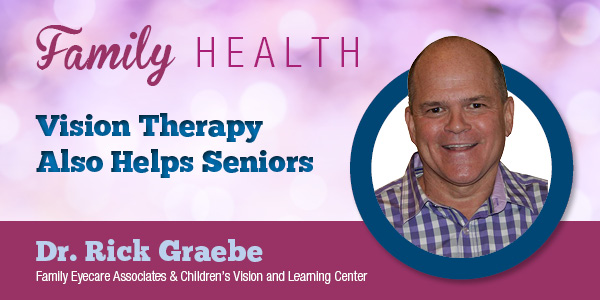Vision Therapy Also Helps Seniors
We all know that as we age our bodies lag behind. We can’t run as fast, lift as much, even stay awake as long as we once did.
The same thing is true of our eyes and visual systems, said Dr. Rick Graebe, a behavioral optometrist in Versailles.
By age 60, Dr. Graebe said, everyone’s eyes receive 30% less light than before, which explains why older adults grow leery of driving at night.
But the biggest changes to our visual systems can come from three areas – cataract surgery, retinal surgery, and strokes or brain injuries.
All of us are candidates for cataracts because it’s a progressive condition in which the eye grows increasingly more opaque causing blurred vision.
The good news is that cataracts are easily treated with a simple procedure where the lens is replaced with an artificial one. Depending on the new lens, nearsightedness and/or farsightedness are suddenly cured.
But because the eyes are now receiving new input, the brain, which is central to the visual system, may have trouble processing that information.
Eyes might not point and track together as well as before, especially with close-up work like reading and computer work.
Dr. Graebe specializes in Vision Therapy, a kind of physical therapy for the eyes, brain and body that treats such conditions as amblyopia (lazy eye), strabismus (eye misalignment), convergent deficiency (inability of eyes to track and point together), and blurred and double vision.
Adults who are post-cataract surgery and experience the conditions above can improve their reading and close-up work skills through Vision Therapy.
The same is true for patients after retinal surgery, which can create some of the same problems that post-cataract patients face.
Up to nine out of 10 people who suffer strokes or brain injuries, Dr. Graebe said, also experience changes to the ambient part of the visual system, which deals with eye pointing and tracking, and spatial awareness and balance.
The Vision Therapy treatment that corrects these changes involves a sequence of non-academic activities that are more like simple games than medical treatment.
“With these older adults, their treatment is similar to young kids whose visual systems have developed improperly,” Dr. Graebe said.
“Sometimes, you might come to our office and see children and older adults doing the same tasks.”
The good news is that whatever the age, the treatment works.

